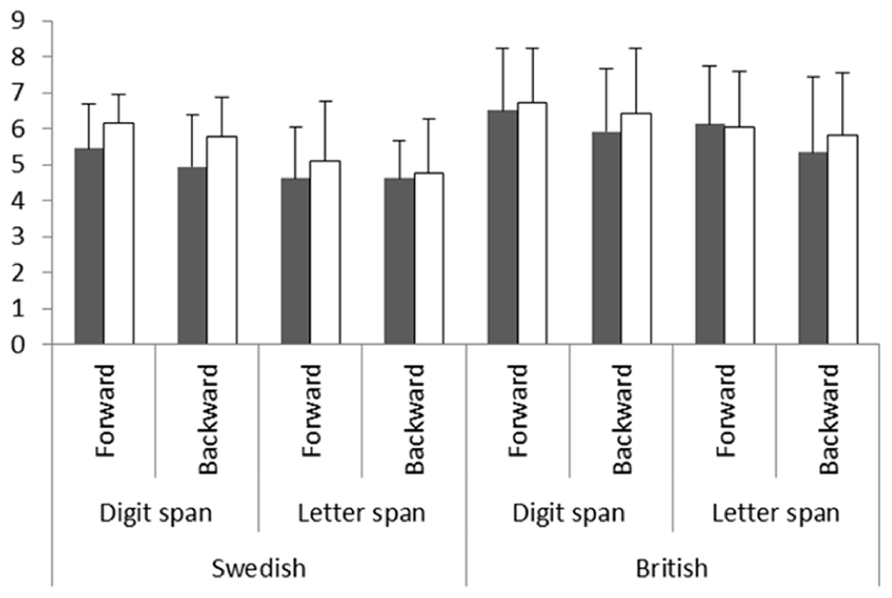
Participants had to repeat back a string of numbers or letters in the same order and the number of digits/letters was gradually increased, until the participants could no longer recall the sequence. Jacobs used a sample of 443 female students (aged from 8-19) from the North London Collegiate School. For example, Jacobs (1887) conducted an experiment using a digit span test, to examine the capacity of short-term memory for numbers and letters. Miller’s (1956) theory is supported by psychological research. When we try to remember a phone number, which has 11 digits, we chunk the information into groups, for example: 0767…819…45…34, so we only need to remember four chunks of information and not 11 individual digits. This can explain why we are able recall items like mobile phone numbers, which contain more than 7 digits. Miller believed that our short-term memory stores ‘chunks’ of information rather than individual numbers or letters.
#Digit span memory test sattler 2 plus
He said that we can hold seven 'items' in short-term memory, plus or minus two. (PsycINFO Database Record (c) 2013 APA, all rights reserved).Miller (1956) published a famous article entitled ‘ The Magical Number Seven, Plus or Minus Two’ in which he reviewed existing research into short-term memory. We conclude by proposing some directions for future research designed to bridge this and other theoretical gaps in the literature.
#Digit span memory test sattler 2 serial
In the spatial domain, there is some evidence for a primacy gradient and position marking, whereas in the visual domain there is no direct evidence for either of the principles of serial order. By contrast, the principles underlying the representation of serial order in the visual and spatial CQ systems are unclear, largely because the relevant studies have yet to be performed. Evidence further indicates that output interference operates during recall and that item similarity effects manifest during both serial order encoding and retrieval. Within the verbal short-term memory CQ system, evidence suggests that serial order is represented via a primacy gradient, position marking, response suppression, and cumulative matching. We propose that functional similarities across domains buttress the notion that verbal, visual, and spatial sequences are planned and controlled by a competitive queuing (CQ) mechanism in which items are simultaneously active in parallel and the strongest item is chosen for output. Here we review phenomena of serial order documented across the verbal, visual, and spatial short-term memory domains and interpret them with reference to the principles of serial order and ancillary assumptions instantiated in contemporary computational theories of memory for serial order. In conclusion, overall, adverse markers of LA structure and function were associated with 2-year detrimental executive function-related cognitive changes in a sample of participants at high risk for cardiovascular disease, highlighting LA substrate as a potential risk factor for cognitive decrease and dementia.įrom vocabulary learning to imitating sequences of motor actions, the ability to plan, represent, and recall a novel sequence of items in the correct order is fundamental for many verbal and nonverbal higher level cognitive activities. Strain measurements were also associated with a 2-year change in the Controlled Oral Word Association Test. Larger LA volume index (standardized β −0.13 ), lower peak longitudinal strain (−0.11 ), and higher stiffness index (−0.18 ) were associated with 2-year worsening in Trail-Making Test A.

LA structure and function were not associated with cognitive function at baseline. Multiple linear regression was used to test associations of atrial markers (modeled in SD units) with baseline and 2-year changes in cognitive scores adjusted for demographic and health covariates. General cognitive functioning (Mini-mental state examination), verbal ability (verbal fluency test), memory and attention (Digit Span Tests), and processing speed and executive function (Trail-Making Tests A and B) were assessed at baseline and at 2-year follow-up. Left atrial (LA) markers (volume index, emptying fraction, strain, function index, and stiffness index) were estimated based on transthoracic echocardiography. We tested associations of echocardiographic markers of atrial structure and function with cognitive function and decrease in 510 participants with obesity and metabolic syndrome (mean age SD of 64.4 years in men and 66.5 years in women). Whether subclinical abnormalities in atrial function and substrate predisposing to atrial fibrillation impact cognitive function has received limited attention. Atrial fibrillation has been associated with cognitive impairment.


 0 kommentar(er)
0 kommentar(er)
